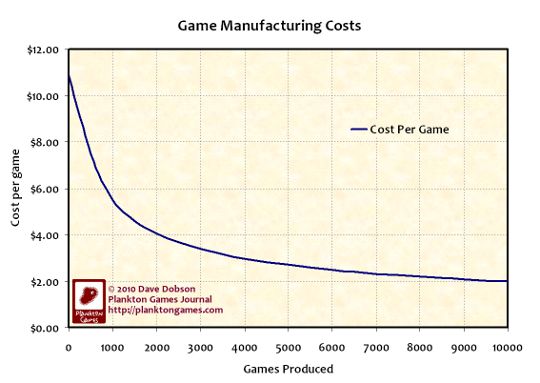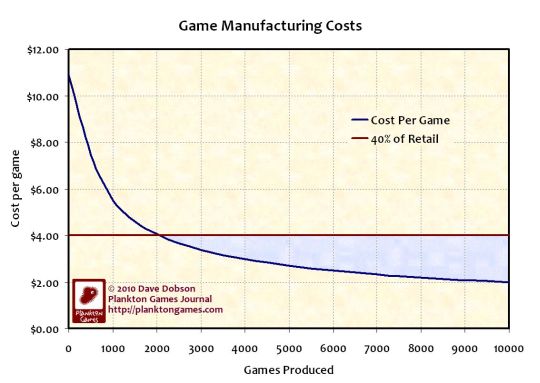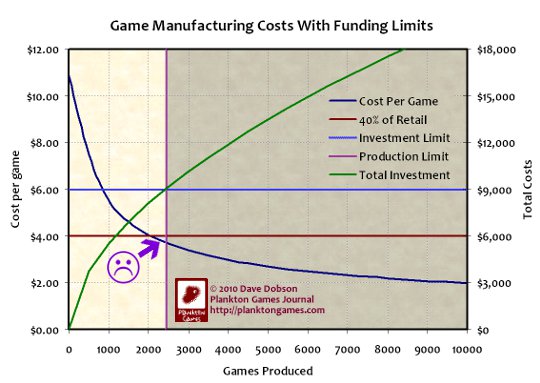Today, I'd like to share my thinking with regard to the economic viability of publishing games with relatively small print runs. This would cover either small game companies or self-publishing - whatever you want to call it, that's what I'm looking to do.
To get started, I've solicited manufacturing cost estimates from a number of manufacturers both in the U.S. and overseas. There is less difference there than I'd thought, although overseas sourcing is a bit cheaper at most production run sizes. That's before factoring in the hassles of additional shipping, customs, transport, etc., which (along with a general preference for U.S. production) may well be enough to move me back to a U.S. printer. Regardless, I've compiled and graphed my various estimates for
Diggity, a card game with 96 cards and a box. Some estimates are higher, and some are lower, but they generally fall along the curve I show here (click on all the graphs to see a larger version):
So, you can see there's a big economy of scale at work, with a run of 2000-3000 games being necessary to get to where the pricing is a good deal cheaper, and a run of 5000 or so to get down to about $2.50 a game.
Knowing how much you can make the games for is only half of the information you need to figure out if this is going to be a profitable venture. You also need to figure out how much you can sell them for. That's tricky - there are a lot of mass-produced card games that are somewhat like Diggity. The GameWright card games retail for about $8-$12. They have a big box, lots of art, and they obviously benefit from a big print run. They usually have fewer cards than my game. Set retails for $12-$14 - also a big, popular game. Fluxx, which is probably more parallel to what I'm doing, retails for more like $15-$16, although it now has a bigger box than I'm including in my estimates here.
Even so, that sounds great - I can make the game for $3-$4, and then sell it for $12, or even $16! Profit! But that's not how it works. The $12 or $16 is the retail price, and other than customers to whom I sell directly, I'm not likely to get the retail price. If I sell directly to a game store, they're going to want to buy it at maybe half of retail, so that they can make a profit. Worse, if I sell through a distributor, the distributor is going to want to buy it from me for maybe 40% of the final retail price, since they need to mark up when they sell to retailers.
Let's make some conservative assumptions. Suppose I'm only able to get a retail price in line with my cheaper competitors, like the GameWright card games. Even if mine's better, and has more cards. Suppose I can get $10 retail for it. That means, if I'm going to sell through distributors, I need to assume I'm only going to get $4 a game for my product. That means I can modify my graph to show where I'm profitable and where I'm not as follows:
On the graph above, I'm only making money on my games if I can get them produced for less than $4, which is only true if I'm in the blue zone. Which means I need to print over 2,000 games just to get to the point where I could possibly make any money. And these are just the production costs - they don't count advertising, legwork, artwork, web design, office supplies, Internet costs, web hosting, shipping costs, transaction fees, returns, spoiled or damaged products, non-payment or outright theft, and on and on.
The above also makes the rosy assumption that I'll sell all the games I make in a reasonable amount of time. It's possible that sales will go very slowly, and even if I'm potentially profitable long-run, I'll have to make a really big initial payment and then wait a long time (years) before I see any return on my investment. Worse, there may not be that many customers out there for my game (although my shareware experience has taught me that the web, and the world, are pretty dang huge). Suppose, though, that the limits of the exposure I can get and the interest of consumers are such that I can only ever expect to sell about 4,000 copies of my game. That's not a conservative estimate - lots of companies go with smaller print runs, and many many games sell less than that number. But even so, that limits my potential profits as shown below:
My blue field of happiness and profitability has gotten a lot smaller. Not looking too good.
Another concern is how big that initial investment has to be. As you can see above, the cost per game decreases significantly the more you buy. The counterpart to that, though, is that the amount you have to invest increases, because you have to buy each of those games to reduce the per-unit cost. The green line shows the total up-front manufacturing cost (marked on the right side of the graph) that I'd have to shell out to get the game printed.
To even get to the blue zone, I'm looking at a significant initial investment just to get started. Here's an example of how that can be pretty grim. Suppose I really want to publish my game, and I want to make a profit doing so. But I only have $9,000 to spare to get started (call that my Investment Limit). If I spend all of that on printing, at the prices above, I can only print about 2400 games (call that my Production Limit) at a cost of about $3.75 a game - barely below the $4 price I can get from the distributors. That's shown here:
My profitable zone has shrunk to a tiny triangle, almost definitely not enough to cover my other expenses, and my business is doomed before it starts.
Depressing, eh? Well, you have to be realistic. But what are some ways that I could push against this inconvenient truth, and actually make a self-publishing or indie company economically viable? Here are a few:
- Put in a lot of money - Suppose you can put in more personal funds, or you can raise money from investors. If you make a bigger initial investment, you'll have lower costs of production, and you'll make more money with every sale. You'll have a lot of products to sell, so you'll want to do a lot of advertising and promoting to get your game noticed by potential customers. But if your game is just not that good, or not that marketable, and you do run into a finite market for your game, you'll just have spent (and lost) more money, and you'll have a lot of sad stacks of little cardboard boxes in your basement.
- Charge a higher price - if you can get people to pay a higher price for your game, then you move the red 40% of retail bar in my graphs upward, and your profitability increases a lot. Given the way the production line is curved, you'll also be able to stay profitable at smaller print runs. Having a higher price than competing games will of course lose you some purchases, but if your game is good enough, and especially if it has some kind of draw, interest, or unique feature that others don't have, you can still sell out. Remember, the benefit of indie publishing is that you need to sell out, but your print runs are pretty small. It's a lot easier to get rid of a couple thousand games than it is to get rid of 10,000 or 20,000.
- Sell direct - This is a big one, and maybe the best option here. If you can sell your games direct to consumers, then you don't have to weather the discounts that distributors and retailers expect - you get the full purchase price, which means your margin is a lot higher. There are a bunch of easy-access ways to do this - through your own website, through eBay, through Amazon - but the challenge is getting noticed. If your game is sold only on the Internet, you've got to be visible to lots of people in places they go to look for games. That's a big challenge. It's possible that you can sell in a variety of ways, too - get your games out to distributors and retailers as best you can, but also sell in person, over the web, at conventions, by the side of the road - anywhere you can find where people are willing to buy.
There are some other ways I think you can get around this perplexing economic model, and I'll discuss them in future posts. But, like any business venture, self-publishing a game or starting a small indie game company is a big gamble, and not a particularly good one. You shouldn't do it with money you can't afford to lose, and you shouldn't stake your career (or your family's future) on succeeding.
































